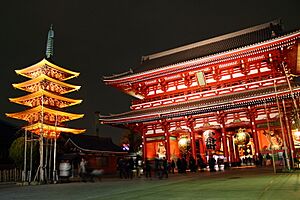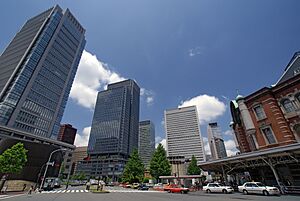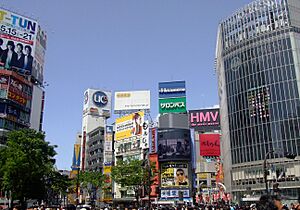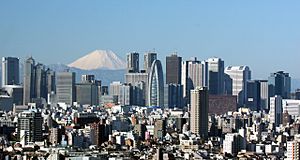Special wards of Tokyo facts for kids
Quick facts for kids
Special wards of Tokyo
東京特別区
|
|
|---|---|
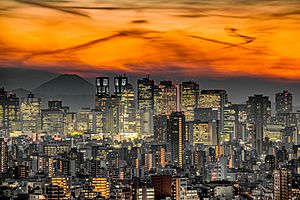
Shinjuku, one of Tokyo's special wards
|
|

Map of Tokyo with special wards in green
|
|
 |
|
| Country | Japan |
| Island | Honshu |
| Region | Kantō |
| Prefecture | Tokyo |
| Area | |
| • Special wards | 618.8 km2 (238.9 sq mi) |
| Population
(October 1, 2020)
|
|
| • Special wards | 9,733,276 |
| • Density | 15,729.27/km2 (40,738.6/sq mi) |
The Special Wards (called 特別区 (tokubetsu-ku) in Japanese) are a special type of city in Japan. They are like cities that make up a larger metropolitan area. Even though they are called "wards," they act a lot like independent cities.
These special wards only exist in Tokyo. Tokyo has 23 special wards. It also has 39 other regular cities, towns, and villages. The special wards cover the area that used to be Tokyo City before 1943. Back then, Tokyo City was abolished, and the area became directly controlled by the Tokyo Metropolitan Government.
After World War II, during the time Japan was occupied, these special wards were created. Each ward got its own elected mayor and assembly, just like any other city. In English, these wards often call themselves "cities." In Japanese, they are often called the "Wards area of Tokyo Metropolis" (東京都区部, Tōkyō-to kubu) or simply the 23 wards (23区, nijūsan-ku).
Contents
How Tokyo's Special Wards Are Different
Even though special wards are independent, they also work together as one big city for some services. For example, the Tokyo Metropolitan Government handles things like water supply, sewage, and fire services for all 23 wards. Regular cities usually manage these services themselves.
The metropolitan government also collects some taxes that would normally go to city governments. This helps pay for the shared services. They also give money to wards that need help funding their local services. Waste disposal is managed by each ward, but they follow rules set by the metropolitan government.
For a long time, special wards were not seen as fully independent local areas under Japan's Constitution. This meant they didn't have the same rights as other cities to make their own laws or elect their leaders. However, in 1998, a new law was passed. This law made the special wards basic local public areas, giving them more financial freedom and a legal status similar to cities. This change became active in the year 2000.
A Look at Their History
The word "special" helps tell them apart from regular wards in other big Japanese cities. Before 1943, the wards in Tokyo City were similar to those in Osaka or Kyoto. Tokyo City started with 15 wards in 1889. Later, in 1932, many areas from five nearby districts were added, creating 20 new wards. This brought the total to 35 wards and made Tokyo City much larger. People sometimes called this bigger city "Greater Tokyo."
From 1943 to 1947
On March 15, 1943, during World War II, Tokyo's local government was changed. The city government and the prefectural government were combined into one single government. The wards then came under the direct control of this new prefectural government. This was part of a plan to tighten control during the war.
From 1947 to 2000
After the war, on March 15, 1947, the 35 wards of the old city were reorganized into 22 wards. Soon after, on May 3, the "Local Autonomy Law" was put into effect, which defined these new "special wards." A 23rd ward, Nerima, was created on August 1, 1947, by splitting an existing ward.
After the war, the US-led occupation helped make local governments more democratic. However, Tokyo City was not brought back. Instead, the special wards were created. Since the 1970s, the special wards have had more independence than regular administrative wards in other cities. Today, each special ward has its own elected mayor and assembly members.
From 2000 to Today
In 2000, the Japanese government officially recognized the special wards as "local public entities." This gave them a legal status very similar to regular cities.
The special wards are very different in size and population. They range from about 10 to 60 square kilometers in area. Their populations vary from less than 40,000 to over 900,000 people. Some wards are even growing as new land is created by building artificial islands. Setagaya has the most people, while Ōta has the largest area.
The total population of the 23 special wards was about 9.7 million people as of October 1, 2020. This is about two-thirds of Tokyo's total population.
Special Wards in Other Areas?
Currently, special wards only exist in Tokyo. However, some politicians in the Osaka area have suggested a plan to replace the city of Osaka with special wards. This would combine many government tasks at the prefectural level and give more power to local governments. A new law in 2012 allows other major cities in Japan to be replaced with special wards if certain conditions are met and citizens approve. But so far, no other prefecture has created special wards.
List of Special Wards
| No. | Flag | Name | Kanji | Population (as of October 2020[update]) |
Density (/km2) |
Area (km2) |
Major districts |
|---|---|---|---|---|---|---|---|
| 01 | Chiyoda | 千代田区 | 66,680 | 5,718 | 11.66 | Nagatachō, Kasumigaseki, Ōtemachi, Marunouchi, Akihabara, Yūrakuchō, Iidabashi, Kanda | |
| 02 | Chūō | 中央区 | 169,179 | 16,569 | 10.21 | Nihonbashi, Kayabachō, Ginza, Tsukiji, Hatchōbori, Tsukishima | |
| 03 | Minato | 港区 | 260,486 | 12,787 | 20.37 | Odaiba, Shinbashi, Hamamatsuchō, Mita, Toranomon, Azabu, Roppongi, Akasaka, Aoyama | |
| 04 | Shinjuku | 新宿区 | 349,385 | 19,175 | 18.22 | Shinjuku, Takadanobaba, Ōkubo, Waseda, Kagurazaka, Ichigaya, Yotsuya | |
| 05 | Bunkyō | 文京区 | 240,069 | 21,263 | 11.29 | Hongō, Yayoi, Hakusan | |
| 06 | Taitō | 台東区 | 211,444 | 20,914 | 10.11 | Ueno, Asakusa | |
| 07 | Sumida | 墨田区 | 272,085 | 19,759 | 13.77 | Kinshichō, Ryōgoku, Oshiage | |
| 08 | Kōtō | 江東区 | 524,310 | 13,055 | 40.16 | Kameido, Ojima, Sunamachi, Tōyōchō, Kiba, Fukagawa, Toyosu, Ariake | |
| 09 | Shinagawa | 品川区 | 422,488 | 18,497 | 22.84 | Shinagawa, Gotanda, Ōsaki, Hatanodai, Ōimachi, Tennōzu | |
| 10 | Meguro | 目黒区 | 288,088 | 19,637 | 14.67 | Meguro, Nakameguro, Jiyugaoka, Komaba, Aobadai | |
| 11 | Ōta | 大田区 | 748,081 | 12,332 | 60.66 | Ōmori, Kamata, Haneda, Den-en-chōfu | |
| 12 | Setagaya | 世田谷区 | 943,664 | 16,256 | 58.05 | Shimokitazawa, Kinuta, Karasuyama, Tamagawa | |
| 13 | Shibuya | 渋谷区 | 243,883 | 16,140 | 15.11 | Shibuya, Ebisu, Harajuku, Daikanyama, Hiroo | |
| 14 | Nakano | 中野区 | 344,880 | 22,121 | 15.59 | Nakano | |
| 15 | Suginami | 杉並区 | 591,108 | 17,354 | 34.06 | Kōenji, Asagaya, Ogikubo | |
| 16 | Toshima | 豊島区 | 301,599 | 23,182 | 13.01 | Ikebukuro, Komagome, Senkawa, Sugamo | |
| 17 | Kita | 北区 | 355,213 | 17,234 | 20.61 | Akabane, Ōji, Tabata | |
| 18 | Arakawa | 荒川区 | 217,475 | 21,405 | 10.16 | Arakawa, Machiya, Nippori, Minamisenju | |
| 19 | Itabashi | 板橋区 | 584,483 | 18,140 | 32.22 | Itabashi, Takashimadaira | |
| 20 | Nerima | 練馬区 | 752,608 | 15,653 | 48.08 | Nerima, Ōizumi, Hikarigaoka | |
| 21 | Adachi | 足立区 | 695,043 | 13,052 | 53.25 | Ayase, Kitasenju, Takenotsuka | |
| 22 | Katsushika | 葛飾区 | 453,093 | 13,019 | 34.80 | Tateishi, Aoto, Kameari, Shibamata | |
| 23 | Edogawa | 江戸川区 | 697,932 | 13,986 | 49.90 | Kasai, Koiwa | |
| Overall | 9,733,276 | 15,724 | 618.8 | ||||
Famous Districts in Tokyo's Wards
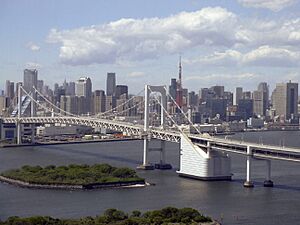
Many important and exciting places are found within Tokyo's special wards:
- Akihabara: This area is famous for electronics, anime culture, and video game arcades. It's a popular spot for fans of Japanese pop culture.
- Asakusa: A historic district known for the Sensō-ji temple, Tokyo's oldest temple. It offers a glimpse into traditional Japan.
- Ginza: A major shopping and entertainment area. You'll find fancy department stores, luxury shops, and movie theaters here.
- Harajuku: Known around the world for its unique Japanese street fashion. It's a great place to see trendy styles.
- Ikebukuro: A very busy area in north-central Tokyo. It has many shops and the famous Sunshine City complex.
- Kasumigaseki: This district is where most of Japan's national government offices are located. The Tokyo Metropolitan Police also has its main office here.
- Marunouchi: A main financial and business district in Tokyo. Many banks and large companies have their headquarters here. It's near Tokyo Station.
- Nagatachō: This is the political center of Tokyo and Japan. The National Diet (parliament) and government ministries are located here.
- Odaiba: A large area built on reclaimed land by the water. It's a popular spot for shopping, entertainment, and has great views of the city.
- Roppongi: Known for its active nightlife, many restaurants, and the Mori Tower. It's popular with both locals and visitors.
- Ryōgoku: This is the heart of the sumo world. It's home to the Ryōgoku Kokugikan, where sumo tournaments are held, and many sumo training stables.
- Shibuya: A long-time center for shopping, fashion, and youth culture. The famous Shibuya Crossing is a must-see for tourists.
- Shinjuku: A major center of Tokyo with many skyscrapers and shopping areas. The Tokyo Metropolitan Government Building is here. The east side of Shinjuku Station has Kabukichō, known for its many bars and nightclubs. Shinjuku Station is the busiest train station in the world.
- Ueno: Famous for its parks, department stores, and many cultural places. Ueno Zoo and Ueno Park are located here. It's also a popular spot to see cherry blossoms in spring.
See also
 In Spanish: Barrios especiales de Tokio para niños
In Spanish: Barrios especiales de Tokio para niños


